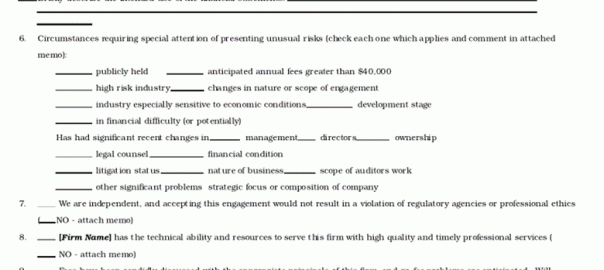— February 25, 2019
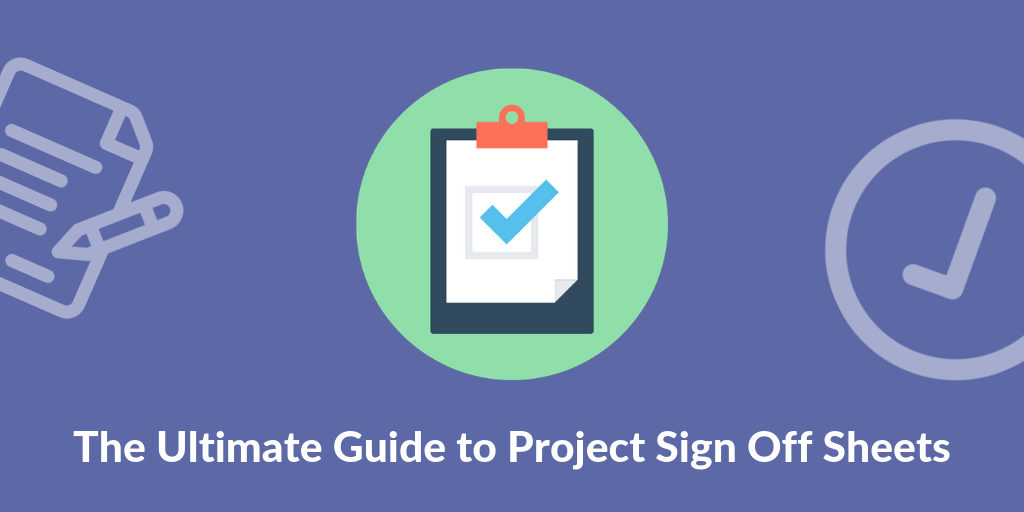
Within any creative process, there may be no definitive end to the new ideas that seem to pop up along the way. While on the one hand, changes and additions to a project can add significant value, they can also derail it if they aren’t kept in check. Using a sign-off sheet is an effective way to keep your project on target and all stakeholders informed and happy with its progress.
Why a Sign-off Sheet Is Indispensable
Sign-off sheets are one of those key pieces of documentation that are essential to any creative process for keeping a record of what’s been agreed upon, where the project is in its course of development, and whether or not all parties are in agreement with the final result.
Without sign-off sheets accompanying the life of a project, your project team and your client may all have different ideas about the project concept, the shape of the deliverables, and even the timeline around which they should be delivered.
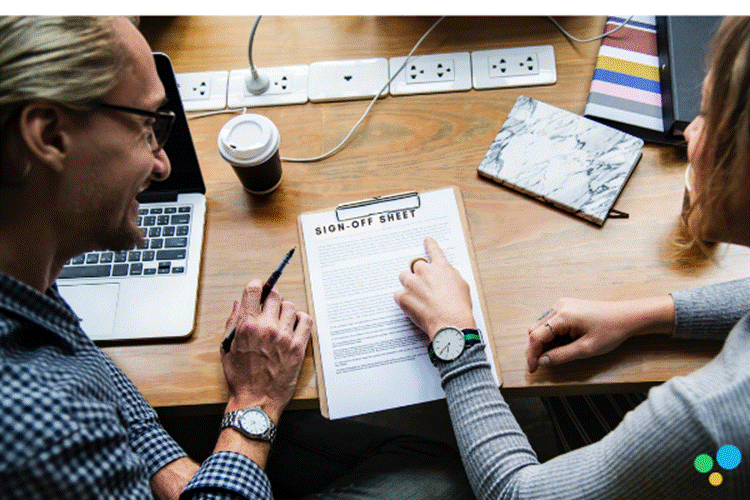
Even for project managers who hate paperwork, the sign-off sheet is a hidden blessing because it serves as a simple reminder of both client and project team expectations. Anyone who has a question about different stages of the project can refer back to the sign-off sheet to see what actions have been taken thus far and who approved each.
3 benefits of sign-off sheets
- Manage expectations between client and creative team
- Allow space for additions or changes while keeping communication clear
- Maintains ultimate accountability for each stage of the project
Using sign-off sheets prevents projects from getting ahead of itself, which is especially important in any creative firm. Each major stage of the project is reviewed and approved to ensure that all stakeholders are happy with its progress before moving forward.
What Does the Project Sign-off Process Look Like?
Obtaining formal sign-off is important because it signifies the official end of a project or completion of a deliverable and the acceptance of the product by the customer (internal or external). While the process is not a complicated one, it is an essential step in ensuring customer satisfaction.
Process for Completed Projects
When your project team has come to the close of the deliverable, you’re ready to review it with the client. Providing an opportunity for a complete customer review will give all stakeholders the space to consider and accept the deliverable, or provide feedback for placing it more in line with client expectations.
Once the project is deemed satisfactory by all stakeholders, the sign-off sheet comes into play. All primary stakeholders will sign their portion of this sheet. Once this sheet is approved, the project has officially come to an end.
Process for Completed Deliverables
If you’re using a sign-off sheet to complete one deliverable that’s a part of a bigger project, then you’ll repeat the previous process until all deliverables in the project have been completed and approved.
A completed sign-off sheet is essential for signifying the end of the project for the single reason that clients may often return with changing requirements, desired additions, or expansions to original products. Once a project is officially closed your team now has the freedom to begin a new project for that client with new payment terms. In this way, you aren’t working endlessly and openly on one project for a finite amount of money.
After the sign-off sheet is completed and the project is done, project managers may want to review the project in its entirety with its team to identify what went well and what can be improved upon. You may even choose to seek the customer’s feedback regarding the project as a whole, the quality of the deliverable, and the consistency of communication between creative team and client.
Filestage Sign-off Sheet Template for Deliverables
The best way to keep client and project team expectations on track is by using a sign-off sheet for each project deliverable. Doing this will prevent the client from adding last minute requests that aren’t within the scope of the project.
It also gives the client complete visibility into the smaller components of the overall project, providing them with important reach into the project flow. They must sign-off on the deliverables by acknowledging their satisfaction with the product, and giving the go-ahead to continue to the next stage in the project.
Sign-off sheets for deliverables provide added protection for the project team because it ensures client expectations are completely in line with creative team expectations. This way there are no surprises along the path toward project completion.
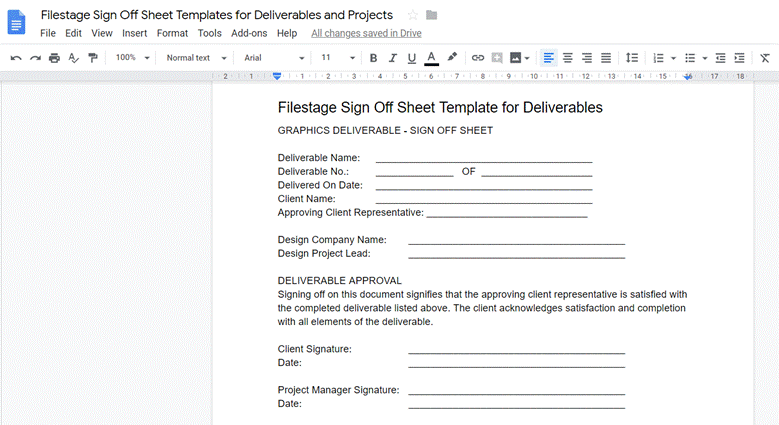
Here’s a template you can use for specific deliverables:
This is how the template looks like:
GRAPHICS DELIVERABLE – SIGN OFF SHEET
Deliverable Name: __________________________
Deliverable No.: ______________ OF ____________________
Delivered On Date: __________________________
Client Name: __________________________
Approving Client Representative: __________________________
Design Company Name: __________________________
Design Project Lead: __________________________
DELIVERABLE APPROVAL
Signing off on this document signifies that the approving client representative is satisfied with the completed deliverable listed above. The client acknowledges satisfaction and completion with all elements of the deliverable.
Client Signature: __________________________
Date: __________________________
Project Manager Signature: __________________________
Date: __________________________
DELIVERABLE NOT APPROVED
If you are not ready to approve this deliverable, please provide feedback below and attach any relevant information to assist the project team in making the changes needed:
__________________________
__________________________
__________________________
__________________________
__________________________
Client Signature: __________________________
Date: __________________________
Filestage Sign-off Sheet Template for Completed Projects
Just as important as each deliverable sign-off sheet is the overall completed project sign-off sheet. Without a signed sign-off sheet, the client may feel entitled to come back with additional requests or changes under the belief that the project never came to an official close, especially if there is no client signature to back it up.
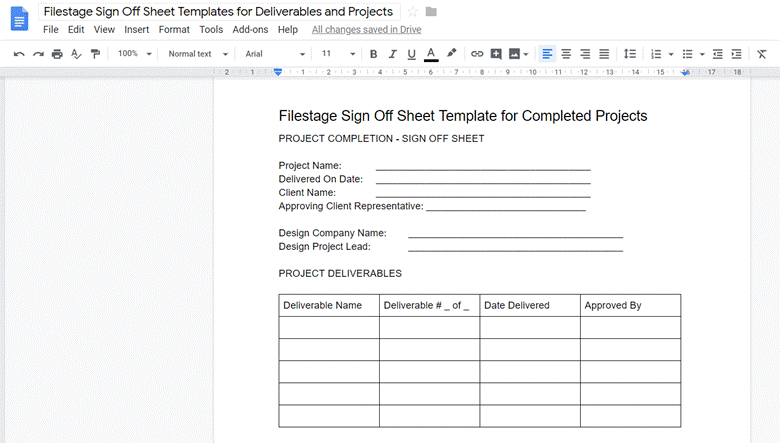
This leaves your project team in a sticky situation, especially if you’ve moved on to a new project for another client. The more you can do to document understanding between client and creative team without getting bogged down in red tape or becoming redundant, the better you off your team will be.
The sign-off sheet also serves as a loud and clear message to the client that they need to give this project their full attention to ensure they are completely happy with the work you’ve provided for them. If they’re not, the sign-off sheet is your way of saying “Speak up now or forever hold your peace.”
PROJECT COMPLETION – SIGN OFF SHEET
Project Name: __________________________
Delivered On Date: __________________________
Client Name: __________________________
Approving Client Representative: __________________________
Design Company Name: __________________________
Design Project Lead: __________________________
PROJECT DELIVERABLES
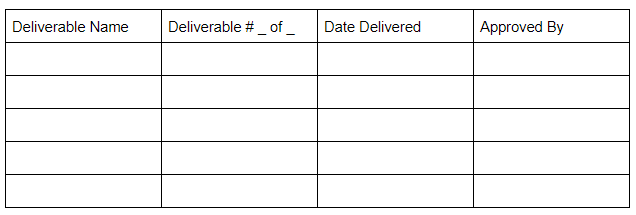
PROJECT APPROVAL
Signing off on this document signifies that the approving client representative is satisfied with the completed deliverables listed in the above table and is not missing any deliverables. The client acknowledges satisfaction and completion with all elements of the project.
Client Signature: __________________________
Date: __________________________
Project Manager Signature: __________________________
Date: __________________________
PROJECT NOT APPROVED
If you are not ready to approve this deliverable, please provide feedback below and attach any relevant information to assist the project team in making the changes needed:
__________________________
__________________________
__________________________
__________________________
Client Signature: __________________________
Date: __________________________
6 Further Sign-off Sheet Templates and Examples You Can Steal
Sign-off sheets can really be as simple or as complex as you need them to be. You don’t have to reinvent the wheel creating one though. Use one of the examples above, or take a look at they myriad of templates available online.
1. Design Sign-off Form
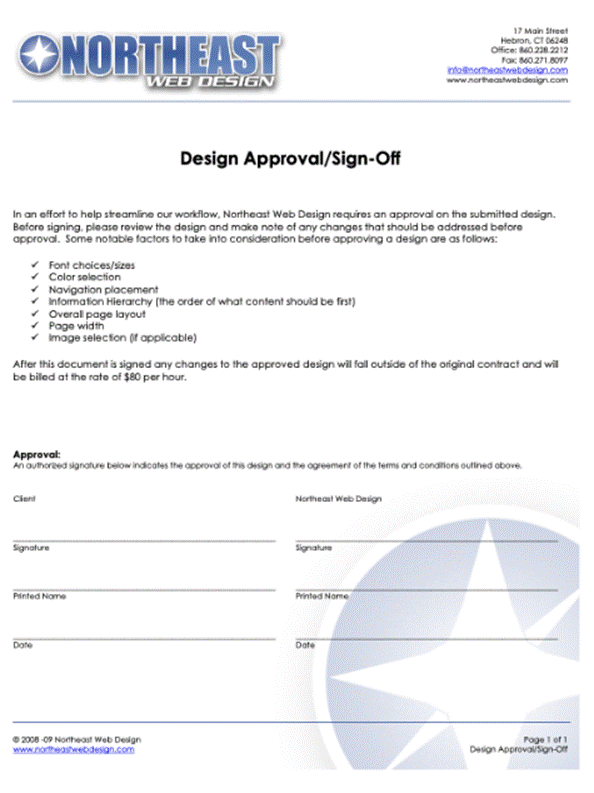
(Source: STUDYLIB)
This example of a design sign-off form specifically defines the parameters of the design approval. By signing this form, the client is consenting to design team’s proposed font choices and sizes, color selections, navigation placement, information hierarchy, page layout, page width, and image selection. They also state in this approval that any changes needed to the design after this approval is signed will be subject to additional charges.
This is a straightforward way to ensure you’re getting paid for the work you’re doing and that the client is happy with what you’ve created for them so far. Add or delete elements of this form to suit your specific needs.
2. Marketing Sign-Off Sheet
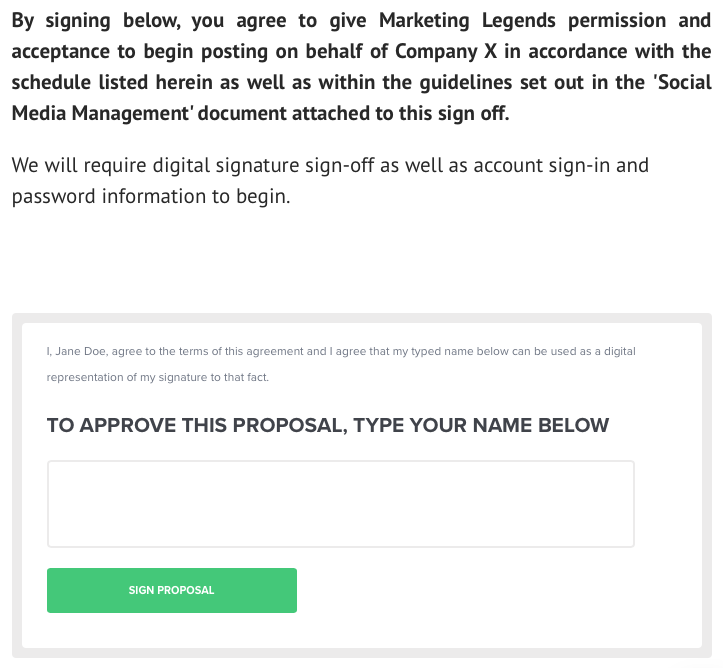
(Source: Better Proposals)
This is an example of a built-in project management system with a client interface for all accompanying documentation. For marketing firms, client approval of every aspect of the proposed marketing strategy is necessary for the successful management of expectations. Along with the marketing, the sign-off sheet should be a copy of the proposed marketing plan in detail.
3. Client Sign-off Template
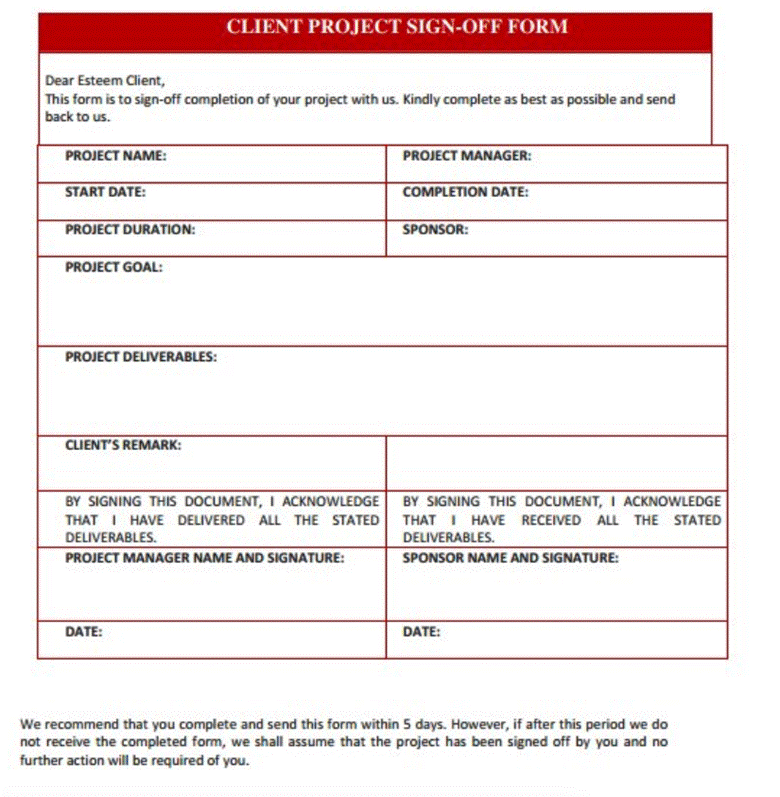
(Source: Gameis.us)
A client sign-off sheet is very similar to a project sign-off sheet. One can be used in place of the other, or they can both be used to emphasize the client’s consent to all deliverables within a project. Whichever you use, language within should be written clearly. It should include fields for the client name (or sponsor), project manager name, and places for both parties to provide a signature under a statement similar to the one listed in the sample: “By signing this document, I acknowledge that I have delivered all the stated deliverables.” or “By signing this document, I acknowledge that I have received all the state deliverables.”
4. Client Acceptance Form
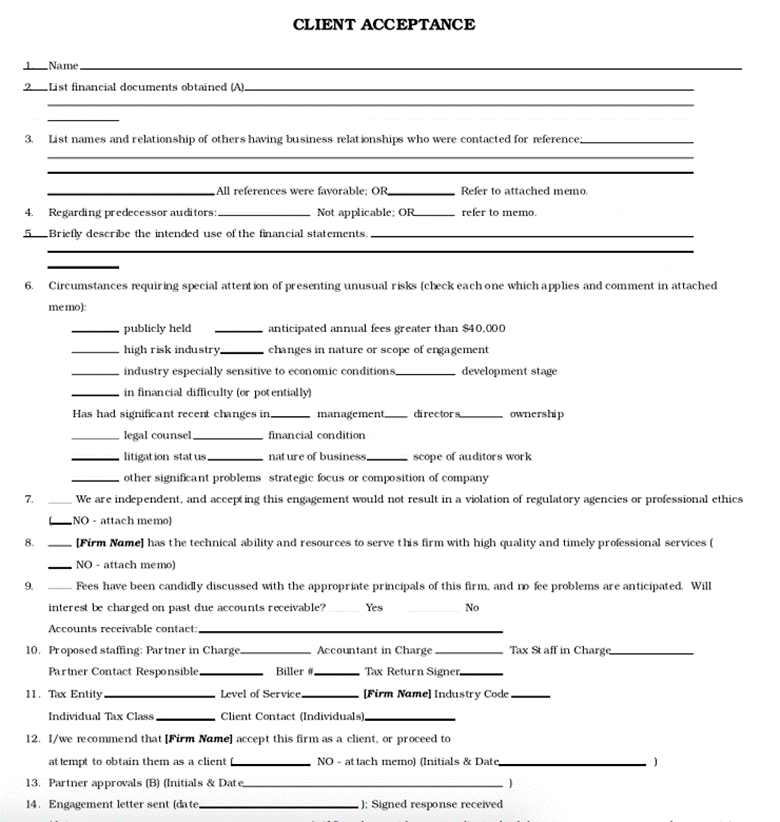
(Source: Scribd)
A client acceptance form establishes the nature of the relationship between creative firm and client and includes all relevant data about the client the creative firm would need to perform the agreed upon services.
Depending on the nature of your business you may not need a client acceptance form that is so detailed. Just include the information you need. You could even combine the client acceptance form with the client sign-off form or project sign-off form to minimize extra paperwork.
5. Project Sign-off Document
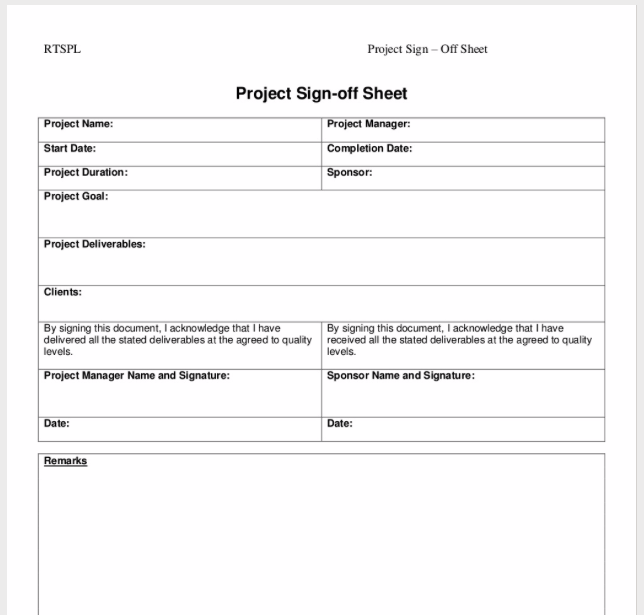
(Source: StudyLib)
This project sign-off sheet is an example of a simple template that can be used to get final client approval of the completed project. This type of form is particularly useful for smaller firms or smaller projects that only consist of a single or a few deliverables.
Use this form as is or expand it to include all of your deliverables to the client so they have a record of everything they have received thus far before approving the final project. Enter as much information you need to without cluttering the form with useless or extraneous information. The more straightforward you are with your client, the more likely they will become a repeat client.
6. Project Acceptance Form
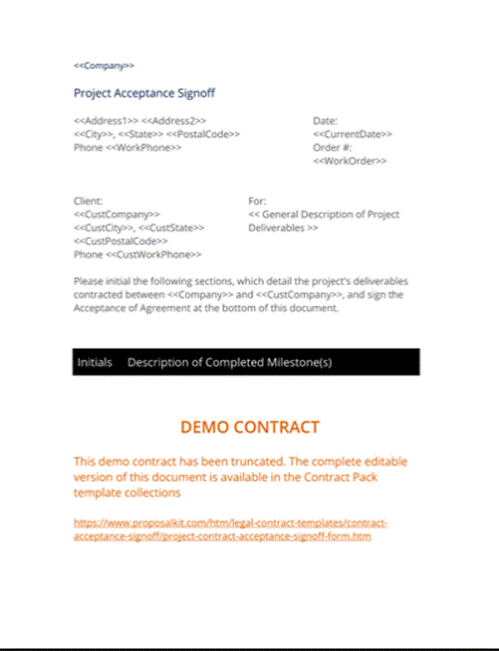
(Source: ProposalKit)
This project acceptance form includes an area for the complete contract between the firm and the client. Whether you choose to include the contract or not, the important part is located in the first half of the form: the client and firm data and a place for a signature of acceptance.
Project acceptance forms can be used at the beginning of the project to mark its start. Or, it can be used after a project has been completed to demonstrate the client’s approval of the deliverable(s).
Conclusion
Use sign-off forms whenever you need to create clear and legitimate understanding about the start or termination of a project, or delivery of products and deliverables. If you aren’t currently employing project management software, a simple document template can be used to create a sign-off sheet.
If you are using project management software, or you’re considering using one, know that many management apps have a customer interface or form builder as part of the package. You can create custom forms and send them to your clients for approval. Whether you use a form builder, use a built-in form, fill out a template online, or create your own sign-off sheet, be sure to use one for every client to optimize your relationship and make your work as efficient as possible.
Business & Finance Articles on Business 2 Community
(708)
Report Post